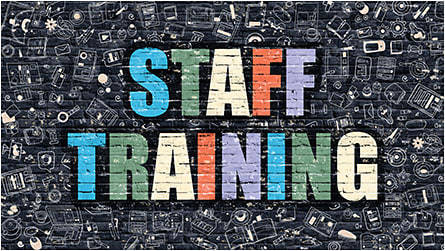WHAT’S YOUR SECRET SAUCE?

TRAINING.
IT’S DEFINITELY NOT JUST FOR NEW HIRES.
In fact, employees report growth and development are key to keeping peeps in place. Your place.
Gallup finds that when the level of training is poor, 4 out of 10 new staffers say sayonara within 12 months. That helps explain why, according to ClearCompany, 68% of workers surveyed say training and development should be an employer’s most important policy.
On the flip side, the majority (51%) of eyecare professional respondents to our recent Eyecare Business 2018 Readership Study say staff training is the No. 1 area that needs attention in their business right now.
So, how do you get your business on the ball with staff training? That’s exactly what we asked several über-savvy eyecare professionals who stress ongoing staff training in their own practices.
90%
An overwhelming majority of EB readers told us they’d like to see staff training covered regularly in the pages of Eyecare Business.
THE HOW
According to Mary Schmidt, ABOC, trainer and president of EyeSystems in Pleasant Hills, CA, all training needs a large measure of affirmation—and a small amount of guidance.
“To make it stick, training should be interesting, relevant, and ideally fun,” adds Schmidt, who is a frequent speaker at Primary Eyecare Network (PEN) staff training workshops.
It’s actually more about learning than training, adds Mario Gutierrez, O.D., of Vision Source Alamo Heights, TX. “There’s a big difference between training or telling somebody what to do and teaching them how to learn. It really sticks when there is learning involved.”
Schmidt agrees. “We only retain a small percentage of what we hear, so the old adage, ‘It takes 21 attempts at a new skill to start to get comfortable and 10,000 executions to become an expert’ is very true in our field.”
THE WHO
Smaller offices may learn together, while larger ones usually train by department. “Now that we’ve grown, we have separate front office, optical department, and clinic meetings,” explains Dr. Gutierrez.


THE WHAT




CERTIFICATION + COMPENSATION
“Certified Paraoptometric (CPO) through the AOA is my recommendation,” says trainer Mary Schmidt, ABOC. “It allows the employer to gauge staff member dedication. As they move up in AOA certification, their skills and value increase, so their compensation should, too. The same holds true for ABO and NCLE.”
THE WHERE



HOW I…
At Salem Eyecare Center, explains Lorie Lippiatt, O.D., “we have maintained training success by implementing…
- “ROLE descriptions that are clearly defined, including cross-training.
- “CHECKLISTS for front desk, pretesting, etc.
- “SCRIPTS for techs to explain instrumentation.
- “ONLINE training for products and software.
- “REPS providing product training during staff meetings.”
However, Lorie Lippiatt, O.D., of Salem Eyecare Center, in Salem, OH, notes: “We provide access to Vision Expo for up to two staff members, chosen by their desire to attend and performance. In return, they are responsible for reporting back to staff at our monthly meeting.” Dr. Lippiatt is also executive vice president of professional strategies for the new Healthy Eyes Advantage (HEA) network.

THE WHY
What’s driving the need for staff training, however it gets delivered?
The patient, says Schmidt. “If staff is not prepared, the practice will lose the sale or the patient.”
Training itself is evolving, becoming more data-based and results-driven.
“The most important factor that has changed performance in our office,” says Dr. Lippiatt, “is the use of real data, demonstrated through our business analytic software, EdgePro. We use the data to show staff the dynamics of the practice—including trends, performance, and opportunities. These are real numbers they can understand.”
One result in using such data, adds Dr. Lippiatt, “is the ability to set training goals around key performance indicators (KPI). The more measurable the goal, the easier for staff to see success. Focusing on one KPI each quarter, with everyone working toward practice improvement, has resulted in tremendous success.”


THE BIG TRAINING CHECKLIST
An expert panel helped us develop this checklist, which shares what to do to keep staff and your business at peak performance levels—from every week to every year.
DAILY

(Millennials prefer it in small bites, so keep input short and on-point.)

(You can’t address a problem if you aren’t there to see it/accessible to act on it.)

BIG TIP:
“Leadership should always be watching for opportunities to affirm a job well done and give corrective guidance if needed.”
Mary Schmidt, ABOC, EyeSystems, Pleasant Hills, CA
WEEKLY

(Review, address, discuss previous week’s successes/problems + any training needs.)

(Schedule a quick 15-minute update of practice performance/problems, including training issues.)

BIG TIP:
“Spend 10 seconds a week telling younger workers what they did well.”
Jason Dorsey, millennial and Gen Z expert
MONTHLY

(Set up an agenda that includes training and time for staff discussion; consider giving small rewards for top performers and best ideas.)

(Check in on those goals previously set together by employee + management.)

(Set up with a vendor rep for CE or internal discussion of new tech, etc.; to be organized by designated manager/senior staffer.)
BIG TIP:
“Reps bring in lunch and talk to staff and doctors about what’s new…and why we should use the latest.”
Eric White, O.D., Complete Family Vision Care Optometry, San Diego
QUARTERLY

(Assigned by manager and tied to staffer’s job function; sources include American Optometric Association, Opticians Association of America, etc.)

(Ask employees to provide feedback based on the practice’s performance + patient satisfaction surveys conducted online and in-office.)

(Ask each staff member to view/listen to one nonoptical video or podcast focusing on customer service, teamwork, etc., available at websites like thetrainingbank.com .)
BIG TIP:
“Focus on one key performance indicator (KPI) per quarter, with everyone working toward practice improvement.”
Lorie Lippiatt, O.D. Salem Eyecare Center, Salem, OH
HALF-YEARLY

(Review with manager; reward based on how well goals met.)

(Pinpoint via vendors + local optometric/opticians’ groups.)

(Assess at hire and review as goals and ways to achieve them change.)
BIG TIP:
“Something as simple as a $25 gift card for meeting or exceeding a goal like improving cancellation rates or presenting add-on options can be a big motivator.”
Lorie Lippiatt, O.D.
ANNUALLY

(e.g., learn new instrumentation, work toward certification, improve add-on sales.)

(Invite suppliers to support employee recognition/celebration dinner—close early and offer live CE, too.)

(Invite employees to attend on a rotating or performance-based schedule. Include company-paid CE in the mix.)
BIG TIP:
“There’s a massive revolution in which timely, personalized employee feedback is replacing antiquated annual evaluations.”
Accenture CEO Pierre Nanterme



